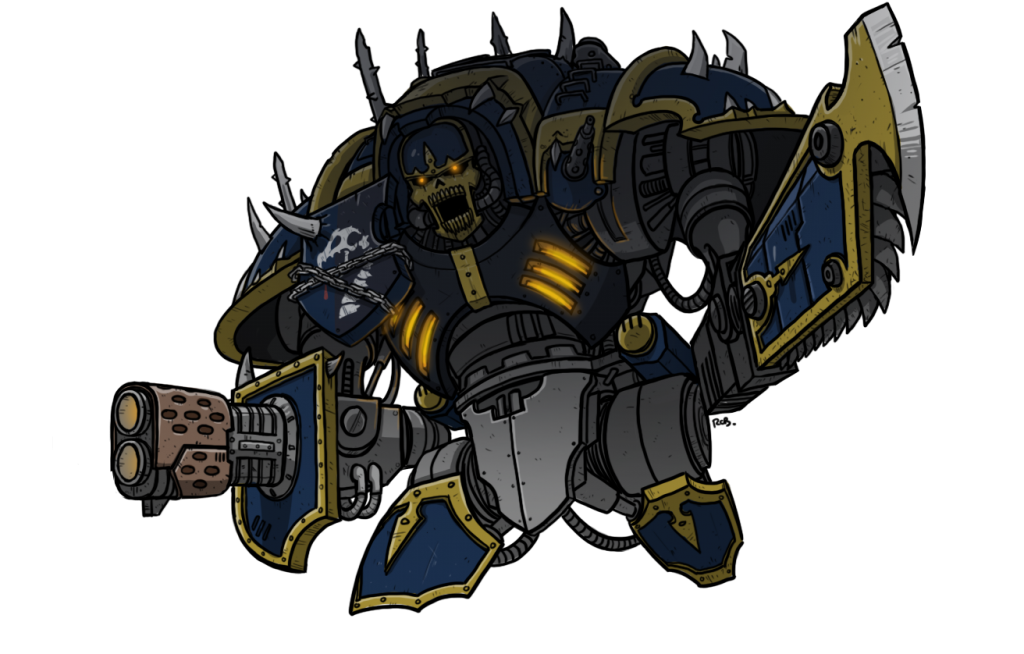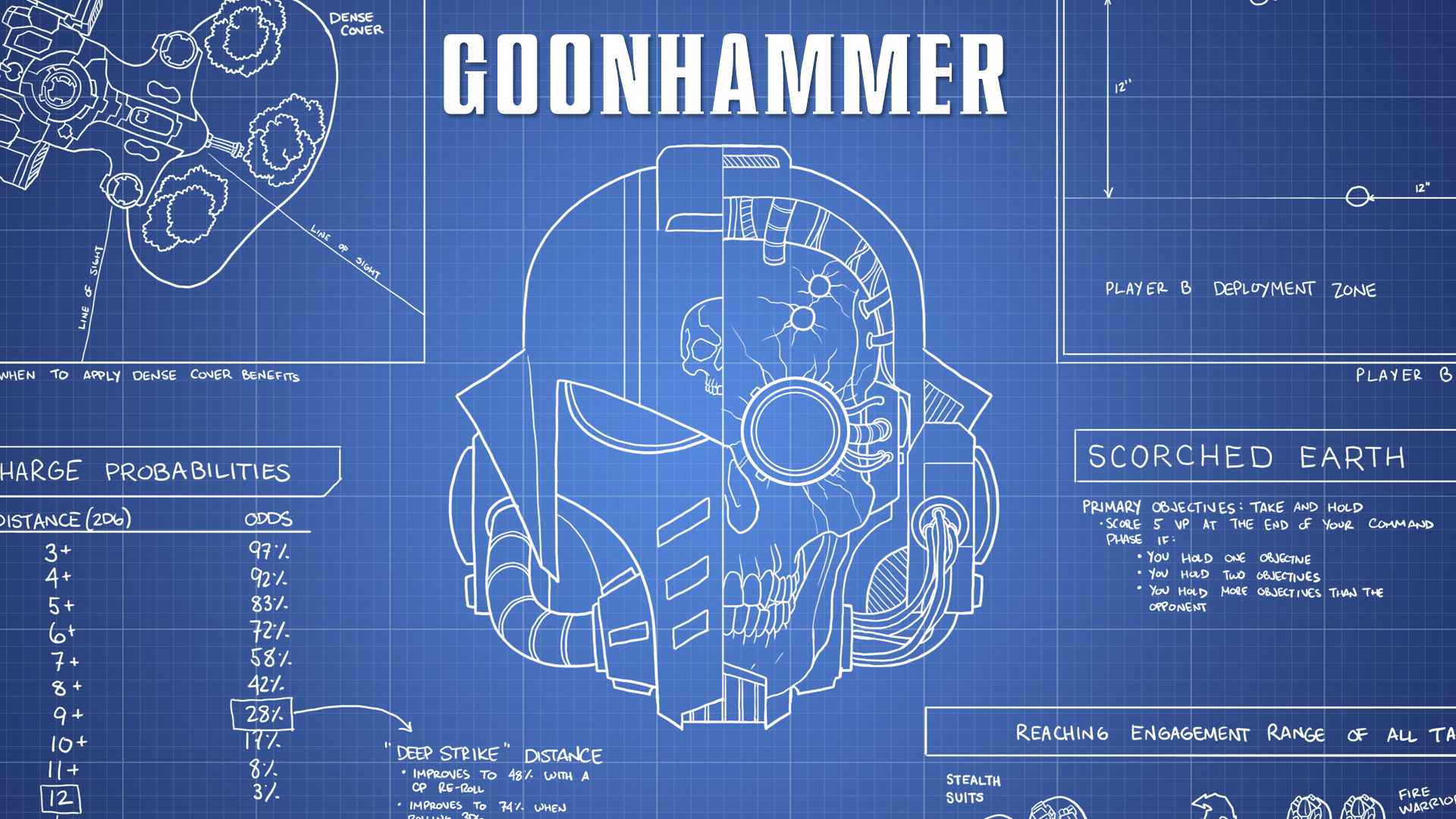Welcome to War Zone: Nephilim! There’s never been a shake-up this large during an edition of 40k, and in June Games Workshop dropped a new missions pack with all-new secondaries, changed how CP works in games, published new, all-digital points for the first time ever, and published a new balance dataslate, dramatically shifting the power levels of some armies.
With any big changes comes a new series of Faction Focus articles and we’re doing the same for Nephilim as we did for Nachmund. In this article we’re talking about Chaos Knights, covering how the faction changed, what it means for playing them, how they’re likely to fare in the new meta. Then we’ll wrap up with a list with some thoughts on playing them.
Chaos Knights saw their 9th edition Codex finally release just a month and a half prior to the Nephilim changes, and had just hit competitive play when a wave of major changes hit. As a result of being a very new release, the faction itself wasn’t changed much, but many of the game-wide changes have large impacts on the faction.
The Notable Changes
As we mentioned, Chaos Knights received fewer specific changes in Nephilim and were more affected by game-wide changes, though there have been several FAQs that adjusted things for the faction.
- FAQ Changes. Several post-Nephilim FAQ changes tweaked the faction. The Stratagem A Long Leash can now be used in either player’s Command phase, while Aura of Corruption got cheaper on War Dogs and more expensive on Tyrant-Class models. The biggest of these however was the adjustment to Storm of Darkness. We all saw this one coming, but having to do the Storm action in your own Morale phase makes it much less brokenly good (though it’s still decent). It’s worth noting with this change you can only ever score 12 points on this secondary since you don’t score at the end of the game.
- List Building Changes. With the Super Heavy Auxiliary detachment becoming free if it matches the faction of your warlord, it effectively adds a free slot to knights who are limited to just 5 units in Super Heavy detachment. Since Chaos Knight Super Heavy Auxiliary detachments act as normal Chaos Knight detachments if you include 3 War Dog models or one big knight, there’s no downside to using this. You should probably always be taking advantage of this, since it lets you access another favor and more importantly lets you split up your drops for deployment, allowing you to spread out more.
- Secondary Changes. A few major changes to secondaries have a large impact on Chaos Knights – the loss of Stranglehold and To the Last affect most of the game’s armies, and they’re certainly secondaries that Chaos Knights would use often. The flip side is that armies can now take multiple selections from their faction secondaries, and this is where Chaos Knights do well, with one of the better faction secondary sets, giving them multiple options that can reliably score 10+ points. The standout winner is Ruthless Tyranny which is effectively just better Stranglehold.
- CP Changes. The biggest change in playstyle when it comes to the new CP rules is that pushing your ion save to a 4++ every turn is no longer something you’ll always be able to do, especially on big knights. In addition, where things like Tormented Wrath and Hungry for Combat were useful, if expensive, tools, you’re likely only going to be using them in specific situations now. Given the importance of Chaos Knight melee combat and how important it is to keep your units alive, you’ll also want to have 2 CP in your back pocket to interrupt in your opponents fight phase to help blunt their assault.
- Engagement Range. Like it or hate it (we aren’t fans), the new 2” ruin engagement range is a big boost to Chaos Knights, who now have an easier time tagging enemy units in melee through ruin walls.
One of the most interesting consequences to the CP changes is that it strangled a large number of armies in the crib – by halving starting CP (but keeping the costs of a Super-Heavy Auxiliary Detachment at 3 CP), GW effectively killed off the prospect of taking a detachment of war dogs in other chaos armies. That’s a shame, given how incredibly effective a trio of Executioners can be at holding backline objectives while providing strong fire support to the likes of Death Guard and Thousand Sons armies that otherwise like strong long range shooting.

Playing Nephilim Missions
While Nephilim CP and Secondary objectives changed, the missions themselves changed very little outside of the way CP is added to the army (1 per turn instead of battle round), so strategies in that sense haven’t changed much – Chaos Knights still rely on a war dog-heavy approach to using cover to mask their advance against heavier shooting, then close in with a strong melee punch.
When it comes to secondary objectives, Chaos Knights are in the same boat as Grey Knights and Thousand Sons in that they start off on the back foot – Bring it Down will always be a 15-point pick against them and reward the opponent for what they already need to do (kill knights), making it important for players to have multiple 15-point options (or at least high-floor 12-pointers) lined up each game. Fortunately, the Chaos Knight secondary objectives provide some strong options.
- Ruthless Tyranny is, as it turns out, a very good replacement for Stranglehold, giving you an easy way to score 3 VP each turn (and similar to Stranglehold, scoring at the end of your turn), with the stretch option to score a 4th point. It’s one of the highest-scoring faction secondaries in the game and it’s pretty consistent.
- Storm of Darkness is the most commonly chosen secondary for Chaos Knights and should reliably score you around 9 VP; 12 is going to be a tall ask, and opponents still have the option to remove your knights before they finish, but 6 is going to be the floor most of the time.
- A Fitting Challenge has you taking out specific targets chosen pre-game, with points for removing them from the table early and often. Because those targets have to be the ones with the highest points value, the value of this secondary is going to depend heavily on what those units are and, fittingly from a lore standpoint, this is going to be most valuable when going up against other knight armies or armies relying on big vehicles and monsters that can’t be protected easily. It’s a pretty average secondary on the whole – it’ll usually be worth 7-8 points – but not something you’re going to want to take very often.
- Path of Destruction scores you VP at the end of the round (up to 3) for destroying enemy units with chaos knights units that are in your deployment zone, in no man’s land, and in their deployment zone. Again, this one is going to depend heavily on the terrain and the opponent (and the deployment zones), and the hoops you have to jump through make it just not worth it – killing an enemy unit with one of your own in your opponent’s deployment zone every round to score 15 is pretty much impossible unless you get off a wild T1 charge with something like a subjugator machine spirit, and the per-round scoring on this makes it just a really bad option. You’re better off going with Grind Them Down.
Most games will see Chaos Knights players taking Ruthless Tyranny, then supplementing that with Grind Them Down and either a kill secondary or Storm of Darkness. For lists taking an Abominant, Psychic Interrogation and Warp Ritual are also options, though whether they’re a better use of your psychic phase than Winds of the Warp or doing mortal wounds will be a gametime decision, largely based on how readily your opponent can deny your attempts and how badly you need the ability to ignore damage.

Squaring Up Against the Meta
Chaos Knights are essentially a skew army – sure, they’re more versatile than your average skew list built from an army that isn’t designed for it, but you’re still taking a large group of vehicles with big bases that just can’t do certain things.
The Positive
As mentioned above, Chaos Knights have access to a lot of really powerful secondaries and are really good at playing the primary with very fast counts-as-five-models obsec bodies. In a lot of matchups you can expect to be holding more objectives as early as turn 2 especially if your opponent makes the mistake of underestimating the speed of your big robots. Chaos Knights are also equipped to be active in every phase of the game and can bring an entire army of hybrid threats that can be equally deadly in melee and shooting. Iconoclasts specifically are also well suited to deal with Armor of Contempt targets since they can boost things like the Reaper Chain-Talon to AP-5 which will let you carve through armor with ease. Chaos Knights also do well against Admech, where they don’t really have to fear the faction’s melee threats and a lack of cognis lascannons in modern armies give them room to roam.
The Struggle
The biggest downside to Knights in general is also one of their biggest strengths – you only have vehicles. Armies like Tau and armor-heavy Astra Militarum will turn your robots into smoldering heaps pretty quickly if you aren’t careful. In addition, the knight vs knight matchup can be a tough one, with whoever gets the first turn being able to decimate their opponent’s larger knights since they can’t hide them. Tyranids may also be an issue.
Lists that take an Abominant may also struggle against the psyker armies like Thousand Sons and Grey Knights because they lose Abhor the Witch as an option while opening themselves up to secondaries like Wrath of Magnus and the added durability they get from Winds of the Warp doesn’t make up for the points they allow, and they don’t gain enough in psychic defenses.

Building Lists
When you sit down to build a Chaos Knights list the question you start with is “how many big knights do I want to take?” Most players have settled now on the idea that lists want to take a Knight Desecrator (Diamonas optional), after which the question becomes how many war dogs you want to include. While there are some two-knight lists out there that run Desecrator/Abominant, lists have recently begun to converge into two groups:
- The single big knight (usually a Desecrator) flanked by war dogs. This is the more mobile of the lists, with lots of mobility around the board edges and better at going wide on 6-objective maps. It also has the ability to take Abhor the Witch.
- Triple big knights. This will usually be a Desecrator, Abominant and either a Rampager or Despoiler, supported by five war dogs.
We’ll look at examples of both below. When it comes to Households, Herpetrax seems like the de facto choice now, though we’ve seen some fringe builds that lean on other households.
Rob: For my money, the Abominant seems like a trap – you don’t get enough value out of it offensively (the gun in particular seems to mostly disappoint), you lose Abhor from taking it, and while it’s often very difficult to kill, it doesn’t actually do much but be difficult to kill. A savvy opponent will just ignore it while kneecapping you by taking out the war dogs.
Norman’s Chaos Knights
++ Super-Heavy Detachment 0CP (Chaos – Chaos Knights) [83 PL, 2CP, 1,550pts] ++
+ Lord of War +
Knight Desecrator [22 PL, -3CP, 430pts]: 5. Infernal Quest, Arch-Tyrant, Bow to None (Herpetrax), Character (Traitoris Lance), House Herpetrax, Reaper chainsword, Stratagem: Relic, Stratagem: Warlord Trait, Undivided – Blessing of the Dark Master, Veil of Medrengard, Warlord
War Dog Executioner Squadron [17 PL, -1CP, 325pts]: House Herpetrax
. War Dog Executioner: Corrupted Heirlooms, Diabolus heavy stubber, Helm of Dogs, Tzeentch – Mirror of Fates
. War Dog Executioner: Diabolus heavy stubber
War Dog Karnivore Squadron [10 PL, 170pts]: House Herpetrax
. War Dog Karnivore: Diabolus heavy stubber, Khorne – Blood Shield
War Dog Karnivore Squadron [9 PL, 160pts]: House Herpetrax
. War Dog Karnivore: Diabolus heavy stubber, Undivided – Mark of the Dread Knight
War Dog Stalker Squadron [25 PL, 465pts]: House Herpetrax
. War Dog Stalker: Daemonbreath spear, Diabolus heavy stubber, Reaper chaintalon, Tzeentch – Pyrothrone, Winds of the Warp
. War Dog Stalker: Daemonbreath spear, Diabolus heavy stubber, Reaper chaintalon
. War Dog Stalker: Avenger chaincannon, Havoc multi-launcher, Slaughterclaw
++ Super-Heavy Auxiliary Detachment -3CP (Chaos – Chaos Knights) [25 PL, , 450pts] ++
+ Configuration +
Detachment Command Cost [-3CP]
Shared Faction Bonus [3CP]
+ Lord of War +
War Dog Stalker Squadron [25 PL, 450pts]: House Herpetrax
. War Dog Stalker: Avenger chaincannon, Diabolus heavy stubber, Reaper chaintalon, Undivided – Warp-borne Stalker
. War Dog Stalker: Avenger chaincannon, Diabolus heavy stubber, Reaper chaintalon
. War Dog Stalker: Daemonbreath spear, Diabolus heavy stubber, Slaughterclaw
++ Total: [108 PL, 2CP, 2,000pts] ++
Created with BattleScribe (https://battlescribe.net)
This list goes hard into swarming the board in obsec bodies and taking advantage of the favor system as much as possible to provide utility to the list. While the Desecrator doesn’t have the durability of the Abominant and is going to be missing The Diamonas, it’s a nice balance of lethality and durability especially since giving it the Veil of Medrenguard means you won’t need to worry about boosting its ion save every turn. While most of the favors here exist to give the list options (like ignoring invulns with the Blood shield or teleporting with Warp Born Stalker), the two most important ones are The Pyrothrone and The Mirror of fate. The Pyrothrone enables you to take the Psychic Interrogation secondary and The Mirror of Fate enables some much needed CP generation. With everything being obsec, you’re going to want to explode out of your deployment zone and get on objective early. Lastly Herpetrax gives the entire list a nice durability boost while also giving you access to the Iconoclast buffs which are very helpful for dealing with Armor of Contempt targets.
Lukash Nahachewsky’s Chaos Knights
Lukash piloted this list to a 4-1 7th-place finish at the Hometown 40k GT in Edmonton, Alberta last weekend, beating another Chaos Knights list, Sisters of Battle, and Tyranids before falling to Tyranids in round 4 and then finishing with a win against Blood Angels. The most notable feature here is the Knight Despoiler, packing double thermal cannons in what is a bit of a blast from the past.
++++ Chaos Knights Super-Heavy Detachment (-5 CP, 2,000 Points) ++++
Iconoclast
House Herpetrax
Abominant 430, Warlord
Rune of Fate 35
Warlord Trait Infernal Quest, Relic Panoply of the Cursed Knights -2cp
Psychic Powers – Winds of the Warp, Coruscating Hate
465pts
Desecrator, Warpstrike Claw 400
Mark of the Dread Knight 40
Relic Diamonas -1cp
440pts
Despoiler, 2x Daemonbreath Thermal Cannon 495
Blessing of the Dark Master 30
Warlord trait Bow to None, Relic Veil of Medrengard -2cp
525pts
War Dog Karnivore Squadron
2 War Dog Karnivores, 280pts
War Dog Stalker Squadron
2 War Dog Stalkers, Avenger Chaincannon, Reaper Chaintalon, 290pts
++++ 2,000 points, 1 CP ++++
Lukash’s list packs heavy firepower in the form of a double thermal cannon despoiler and a Diamonas-equipped Desecrator. The trick here is basically to dare the opponent to have the firepower to deal with three large knights, where many lists will struggle to deal with more than two. An opponent that can’t focus down a single knight (and then some) in one turn is going to find themselves overpowered quickly against a triple knight list.
Wrapping Things Up
That concludes our look at Chaos Knights but we’ll have more over the next few weeks as we cover each of the game’s factions and some of the subfactions. Until then, if you have any questions or feedback, drop us a note in the comments below or email us at contact@goonhammer.com.



